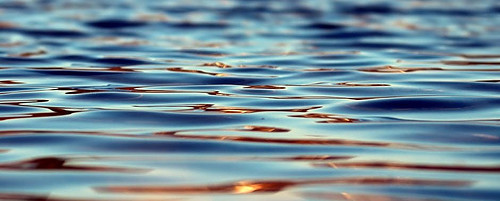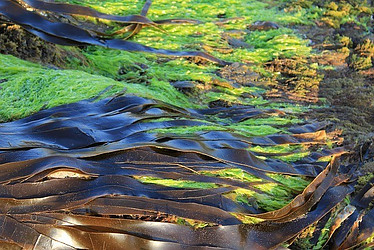Water
The best source of fresh water along the coast will come from small river outlets. Large river outlets tend to be full of silt as well as contamination from industry and human activity further upriver.
Along sandy shores where there are few, if any, small river outlets, fresh water can be found in pools among and between the dunes. If you dig above the high water mark on any beach, especially if there is vegetation, may also bring results. Dig down, until you reach moist sand and let the water accumulate. Harvest the top-most layer of water as fresh water floats on top of salt water.
Rock pools are unlikely to contain fresh water, even if you look about the high water mark. The water accumulated here could simply be the result of a splashing wave. However, you can identify fresh water by the presence of green algae, which is not grazed by mollusks, as it would be if it were located anywhere else on the beach. The reason for this conclusion is simple: salt water mollusks can not survive in the reduced salinity of fresh water.
Alternatively, you can look for water trickling from rock faces, especially where there are ferns or mosses growing out of them – this water will be drinkable. If stranded on a rocky outcrop off the shore, the only reliable source of water will be seawater. However, NEVER drink sea water without distilling it first. Instead of quenching your thirst, it will take valuable body fluids away from vital organs, cause your kidneys to fail and eventually cause brain damage.
However, – sea water CAN be used for cooking – but do not eat until you have a reliable source of adequate drinking water. Also, the residue from distilling salt water can be used to preserve fish and other meats.
Food
Seashore plants will differ from climate to climate but they will be available when either the weather or tides prevent you from gathering seafood. In the water, you will find seaweed wherever you find rocks that allow them enough safety to grow but also where it is shallow enough for sunlight to reach.
Seaweeds (i.e. algae) are very valuable as a food source. In many parts of the world, they form an important part of the average diet. Many are considered a delicacy in such varied offerings from the cuisine of Japan to the laver bread of Wales. Seaweeds can be dried and stored for months.
Note: Seaweeds are a valuable part of your diet – but DO NOT eat the blue-green algae sometimes found in freshwater pools – it is very poisonous.
Seafood
The best hunting for fish and mollusks will be at low tide when rock pools can be inspected and buried mollusks as well as other creatures can be dug from sandy shores.
Only eat mollusks that are freshly collected. Bivalves, such as oysters, clams and mussels, should close tightly if tapped gently. Be careful, bivalves, which feed by filtering water through their digestive systems, can build up dangerous concentrations of toxic chemicals in areas polluted by industry or sewage.
Gastropods such as winkles and whelks have a ‘trap-door’ to close the entrance to their shell. It should close tightly if the shell is shaken. Other gastropods, such as limpets and abalones, do not have a ‘trap door’, but instead are tightly anchored to the rocks. Use a knife (if available) under the edge of the shell to pry them off. If they are hard to dislodge, they are fresh and therefore good to eat. If they come off too easily, they are probably dead or sick – discard them. Searching for them after high tide is a good time – any healthy specimens will still be fastened to rocks, while the sickly ones would have been washed out to sea.
Cook all shelled food by dropping them in boiling water and letting them boil for at least five minutes. If you eat shell foods raw, you run the risk of exposing yourself to parasites and pollutants that they may carry.
Fishing
Fish and sea snakes require more effort to catch. Some fish are dangerous and all sea snakes are venomous. You can tell the difference between sea snakes and eels by their scales and their broad flattened tails. Records of sea snake bites to swimmers are rare. Bites, if they do occur, usually involve fishermen who are trying to remove fish from their nets and don’t notice the snakes who were also caught.
The best time to fish on most coasts and shores is about two hours after high tide. If you attempt to fish while the tide is still coming in, you are likely to constantly retreating from the water and probably getting wet. Always keep in mind that salt water will rot boots and clothing.
Fishing in salt water requires larger hooks than when fishing in fresh water. In the prior case, a wide variety of bait can be used. Limpets, for example, can often be found clinging to rocks. Lugworms can be dug up on sandy and muddy beaches. During low tide, you can look for the coiled worm-casts that show you where their L-shaped burrows are.
Make use of the tide cycle to help you catch fish. You can do this by building large arrow-shaped fish traps from stakes or rocks. Point them away from shore – the fish will be caught when the tide recedes.
Dangers
Unless very still, water higher than your thighs will generally be murky and very hard to see through. You risk stepping on to something unpleasant and the ocean waves could sweep you on to rocks or coral, creating an unnecessary injury in an already difficult situation.
In tropical zones, mussels are poisonous, especially when the oceans are reddish or highly phosphorescent. In the Arctic, black mussels can be poisonous anytime of the year. Learn to recognize the coneshell species that shoot out a poisonous barb potent enough to kill you. There are more than 400 types of cone shell, mostly found in the tropical portion of the Indo-Pacific region. There are about 12 species that are found off the southeast coast of North America and in the Caribbean. They are all easily identified by their shape. Tenebra or Auger and Turrid shells also have poison darts. However, their venom is not dangerous to man, in spite of the potentially painful sting.
Jellyfish – are often swept inshore after a storm. Some, especially in the tropics, sting severely.
The Sea Wasps (Box Jellies), of the northern Australian shores, are the most dangerous. You can identify them by their bell-shaped body. The body itself only reaches about 10 inches in size but it’s tentacles can reach up to 30 ft. Almost transparent and very hard to see, each tentacle is armed with millions of stinging cells. Although their venom is one of the most deadly known and high concentrations of it can cause skin lesions and death, only a very high dosage can kill a human being.
Some jellyfish are not poisonous but be careful because size is not an indication of potency. If you are stung, do NOT pull the tentacles off or wipe the slime with your hand, you will just get stung more. Use seaweed, cloth, or anything else to wipe the sting away.
Portuguese-man-of-war – looks like a jellyfish but is actually a colony of polyps. Like the Sea Wasps, it can also have tentacles up to 30 ft. long. Though its stings may cause irritation for several days, they are seldom fatal. Treat these stings in the same way as a jellyfish sting.
Weaverfish – are found buried in the sand off the shores of Europe, West Africa, and the Mediterranean. Their spines are venomous but not fatal. Apply very hot water to soothe any wounds.
Stingrays – can be found inshore everywhere. However, they are more common in warm waters, and electric rays in warm to temperate zones. They are great at camouflage and they don’t only hide in sand – they also hide in rocky and pebbly places. Play is safe, poke the bottom of the area you intend to walk with a stick as you go. As with the Weaverfish, Stingray wounds can be soothed with very hot water.
Moray Eels – will likely be found in shallow water. They have a savage bite and guard their holes tenaciously. Keep clear of any you happen to see and do NOT put you hands into any crevices!
Giant Clams – are mostly found in the reefs of tropical waters and can be big enough to trap a limb if they snap shut on you.
Corals – are the basis for coral reefs. They are very sharp and can easily cut you. One of my friends, who was in the US Navy, told me a story about a submarine that was forced to return to base after the bottom of its hull was cut open by a coral reef. If coral can damage the bottom of a nuclear sub, imagine what it can do to you.
Some forms such as the fire corals, sting on contact. Always approach a reef with caution. Exploit other sites for food first, explore a reef as your last resort. Both the reef and its inhabitants – which may include cone shells – can present dangers.
Fish – with venomous spines often live in shallow waters. The most dangerous are found in the tropics – a few occur in temperature waters. Bottom-dwelling types are very difficult to detect because of their generally superb camouflage. Zebra fish are easier to spot, but are equally dangerous to contact. Use a stick to stir up the sand and ricks in front of you.
Sea Snakes – often occur in small groups close to shore in the Indian and Pacific oceans. They are generally inoffensive and bites are rare – but their venom is among the most toxic of all snake venom. You definitely want to keep clear of snakes in the water but pin any you find on land with a forked stick – they do make a good meal.
Sharks – mostly feed in deep waters although some species frequent shallow waters and swim up rivers. Believe it or not, some might come onshore looking for an easy meal. Most shark attacks on people occur in very shallow water, so be watchful!
Lagoons – Reefs are often formed around tropical islands or a little way out from shore. This formation creates a breakwater which leaves still waters in a lagoon. Unfortunately, fish in a lagoon are often of the venomous type. Barracuda and Red Snapper, which are edible in the open sea, should be avoided if caught in lagoons. Their eating habits in lagoons cause them to become toxic. If fishing, do so on the sea-facing side of the reef, not the lagoon side.

